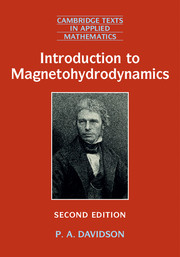Book contents
- Introduction to Magnetohydrodynamics
- Cambridge Texts in Applied Mathematics
- Introduction to Magnetohydrodynamics
- Copyright page
- Dedication
- Contents
- Preface to the Second Edition
- Preface to the First Edition
- Part I From Maxwell’s Equations to Magnetohydrodynamics
- 1 A Qualitative Overview of MHD
- 2 The Governing Equations of Electrodynamics
- 3 A First Course in Fluid Dynamics
- 4 The Governing Equations of MHD
- Part II The Fundamentals of Incompressible MHD
- Part III Applications in Engineering and Materials
- Part IV Applications in Physics
- Book part
- References
- Index
1 - A Qualitative Overview of MHD
from Part I - From Maxwell’s Equations to Magnetohydrodynamics
Published online by Cambridge University Press: 09 February 2017
- Introduction to Magnetohydrodynamics
- Cambridge Texts in Applied Mathematics
- Introduction to Magnetohydrodynamics
- Copyright page
- Dedication
- Contents
- Preface to the Second Edition
- Preface to the First Edition
- Part I From Maxwell’s Equations to Magnetohydrodynamics
- 1 A Qualitative Overview of MHD
- 2 The Governing Equations of Electrodynamics
- 3 A First Course in Fluid Dynamics
- 4 The Governing Equations of MHD
- Part II The Fundamentals of Incompressible MHD
- Part III Applications in Engineering and Materials
- Part IV Applications in Physics
- Book part
- References
- Index
Summary
Information
- Type
- Chapter
- Information
- Introduction to Magnetohydrodynamics , pp. 3 - 26Publisher: Cambridge University PressPrint publication year: 2016
Accessibility standard: Unknown
Why this information is here
This section outlines the accessibility features of this content - including support for screen readers, full keyboard navigation and high-contrast display options. This may not be relevant for you.Accessibility Information
- 1
- Cited by
